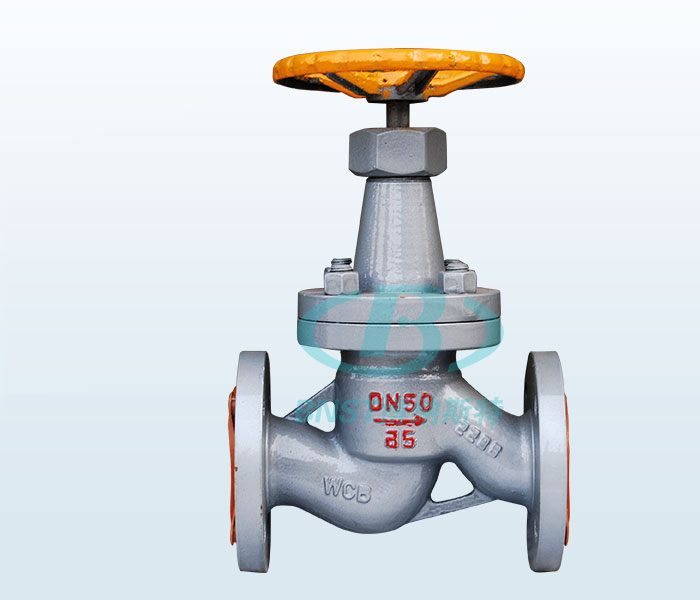Dark rod ammonia shut-off valve

Dark rod ammonia shut-off valve
Nominal diameter: DN15 ~ DN300
Nominal pressure: PN16 ~ PN25
Medium: liquid, gas, ammonia, nitrogen, hydrogen,
Temperature: -10 ℃ -150 ℃
Body Material: Cast iron, cast steel
Operation: manual , gear drive, electric, pneumatic and other
design and manufacturing: GB12235
structural length: GB12221
flange dimensions: GB9113 JB79
pressure - temperature: GB9131
test - test: GB / T13927 JB / T9092
1. Structural features and uses
1. The medium-pass flange is square structure, and the valve stem is connected by a rod.
2. The sealing surface of the valve body adopts a spherical convex shape, and is sealed with the valve foot by a line.
3. The sealing surface is made of babbitt alloy, which has good sealing performance and long service life.
Ammonia shut-off valves often use oxygen, nitrogen, hydrogen, argon and other gases. These gases are typically stored in dedicated high pressure gases. When in use, the gas pressure is reduced to the required range by the ammonia shut-off valve, and then finely adjusted by other control valves to make the gas input into the system. The most commonly used pressure reducing valve is a shut-off valve for ammonia, referred to as a valve for ammonia.
Second, the performance specification
Nominal pressure PN (MPA) | Test pressure PS (MPa) | Applicable medium | Applicable temperature (°C) | |
2.5 | 3.8 | Ammonia gas, | Babbitt alloy | PTFE |
4.0 | 6.4 | |||
Third, the main size and weight:
Nominal diameter | Size (mm) | |||||||||||
L | D | D1 | D2 | D4 | b | f | F1 | Z-φd | turn off | open | D3 | |
10 | 130 | 90 | 60 | 40 | 35 | 16 | 2 | 4 | 4-φ14 | 165 | 185 | 110 |
15 | 130 | 95 | 65 | 45 | 40 | 16 | 2 | 4 | 4-φ14 | 165 | 185 | 110 |
20 | 150 | 105 | 75 | 55 | 51 | 18 | 2 | 4 | 4-φ14 | 170 | 200 | 120 |
25 | 160 | 115 | 85 | 65 | 58 | 18 | 2 | 4 | 4-φ14 | 197 | 210 | 120 |
32 | 180 | 135 | 100 | 78 | 66 | 20 | 2 | 4 | 4-φ18 | 199 | 213 | 140 |
40 | 200 | 145 | 110 | 85 | 76 | 20 | 3 | 4 | 4-φ18 | 248 | 264 | 160 |
50 | 230 | 160 | 125 | 100 | 88 | twenty two | 3 | 4 | 4-φ18 | 265 | 295 | 180 |
65 | 290 | 180 | 145 | 120 | 110 | twenty four | 3 | 4 | 8-φ18 | 310 | 349 | 220 |
80 | 310 | 195 | 160 | 135 | 121 | 26 | 3 | 4 | 8-φ18 | 340 | 357 | 240 |
100 | 350 | 230 | 190 | 160 | 150 | 30 | 3 | 4.5 | 8-φ23 | 380 | 413 | 280 |
125 | 400 | 270 | 220 | 188 | 176 | 32 | 3 | 4.5 | 8-φ25 | 430 | 451 | 320 |
150 | 480 | 300 | 250 | 218 | 204 | 32 | 3 | 4.5 | 8-φ25 | 505 | 492 | 360 |
200 | 600 | 360 | 310 | 278 | 260 | 34 | 3 | 4.5 | 12-φ25 | 550 | 806 | 400 |
250 | 650 | 425 | 370 | 335 | 31 | 36 | 3 | 4.5 | 12-φ30 | 730 | 880 | 450 |
300 | 750 | 485 | 430 | 390 | 364 | 40 | 3 | 4.5 | 16-φ30 | - | 995 | 550 |
Fourth, the appearance and working principle
The high pressure chamber of the ammonia valve is connected with the cylinder, the low pressure chamber is the gas outlet, and leads to the use system. The indication of the high pressure gauge is the pressure of the stored gas in the cylinder. The outlet pressure of the low pressure gauge can be controlled by an adjustment screw.
When using, first open the cylinder main switch, then turn the low pressure gauge pressure adjusting screw clockwise to compress the main spring and drive the film, spring block and ejector to open the valve. The imported high-pressure gas is depressurized by the high-pressure chamber and then enters the low-pressure chamber and leads to the working system through the outlet. Turn the adjusting screw to change the height at which the valve opens, thereby adjusting the throughput of the high pressure gas and achieving the desired pressure value.
The ammonia shut-off valve is equipped with a safety valve. It is a device that protects the ammonia gas pressure reducing valve and makes it safe to use, and is also a signal device for the failure of the ammonia gas pressure reducing valve. If the outlet pressure rises by itself and exceeds a certain permissible value due to damage to the valve mat, valve or other reasons, the safety valve automatically opens the exhaust.
V. Method of use
(1) There are many specifications for ammonia gas pressure reducing valves depending on the requirements of use. The highest import pressure is mostly, the minimum import pressure is not less than 2.5 times the export pressure. There are many export pressure specifications, generally, the highest outlet pressure is.
(2) When installing the ammonia gas pressure reducing valve, make sure that the connection specifications are consistent with the joints of the system. The ammonia shut-off valve is connected by a hemispherical surface, and the nut is fully fitted by tightening the nut. Therefore, the two hemispheres should be kept clean during use to ensure a good airtight effect. High pressure gas can be used to blow off dust before installation. If necessary, a material such as polytetrafluoroethylene may be used as the gasket.
(3) The shut-off valve for ammonia should be strictly prohibited from contact with grease to avoid a fire accident.
(4) When the work is stopped, the residual gas in the pressure reducing valve should be drained, and then the adjusting screw should be loosened to prevent the elastic component from being deformed for a long time.
(5) The shut-off valve for ammonia should avoid impact vibration and should not be in contact with corrosive substances.







